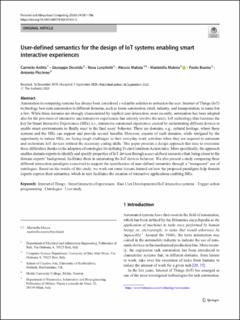| dc.description.abstract | Automation in computing systems has always been considered a valuable solution to unburden the user. Internet of Things (IoT) technology best suits automation in different domains, such as home automation, retail, industry, and transportation, to name but a few. While these domains are strongly characterized by implicit user interaction, more recently, automation has been adopted also for the provision of interactive and immersive experiences that actively involve the users. IoT technology thus becomes the key for Smart Interactive Experiences (SIEs), i.e., immersive automated experiences created by orchestrating different devices to enable smart environments to fluidly react to the final users’ behavior. There are domains, e.g., cultural heritage, where these systems and the SIEs can support and provide several benefits. However, experts of such domains, while intrigued by the opportunity to induce SIEs, are facing tough challenges in their everyday work activities when they are required to automate and orchestrate IoT devices without the necessary coding skills. This paper presents a design approach that tries to overcome these difficulties thanks to the adoption of ontologies for defining Event-Condition-Action rules. More specifically, the approach enables domain experts to identify and specify properties of IoT devices through a user-defined semanticsthat, being closer to the domain experts’ background, facilitates them in automating the IoT devices behavior. We also present a study comparing three different interaction paradigms conceived to support the specification of user-defined semantics through a “transparent” use of ontologies. Based on the results of this study, we work out some lessons learned on how the proposed paradigms help domain experts express their semantics, which in turn facilitates the creation of interactive applications enabling SIEs. Keywords: internet of things, smart interactive experiences, end-user development of IoT interactive systems, trigger-action, programming, ontologies, user study | en_US |

